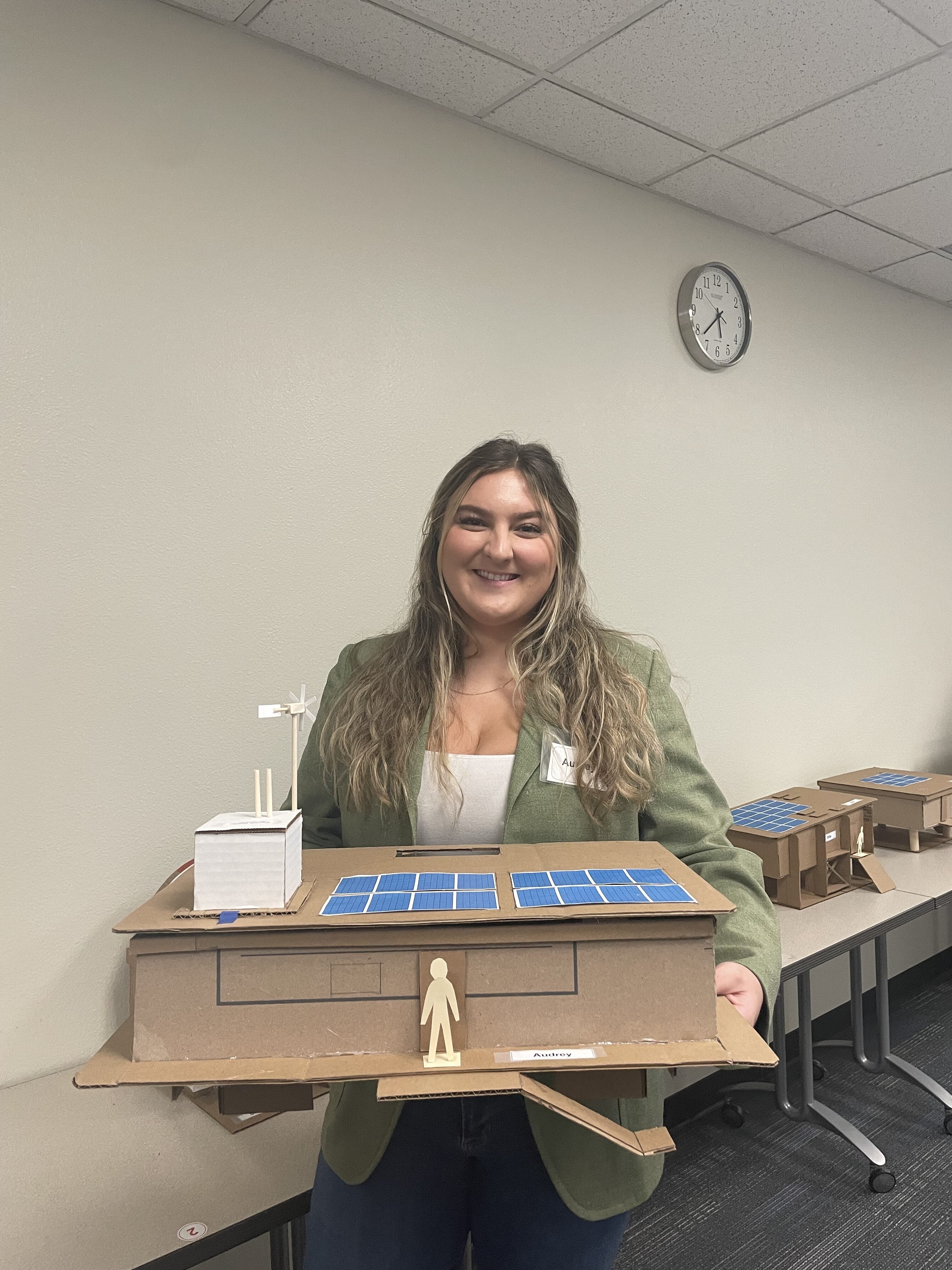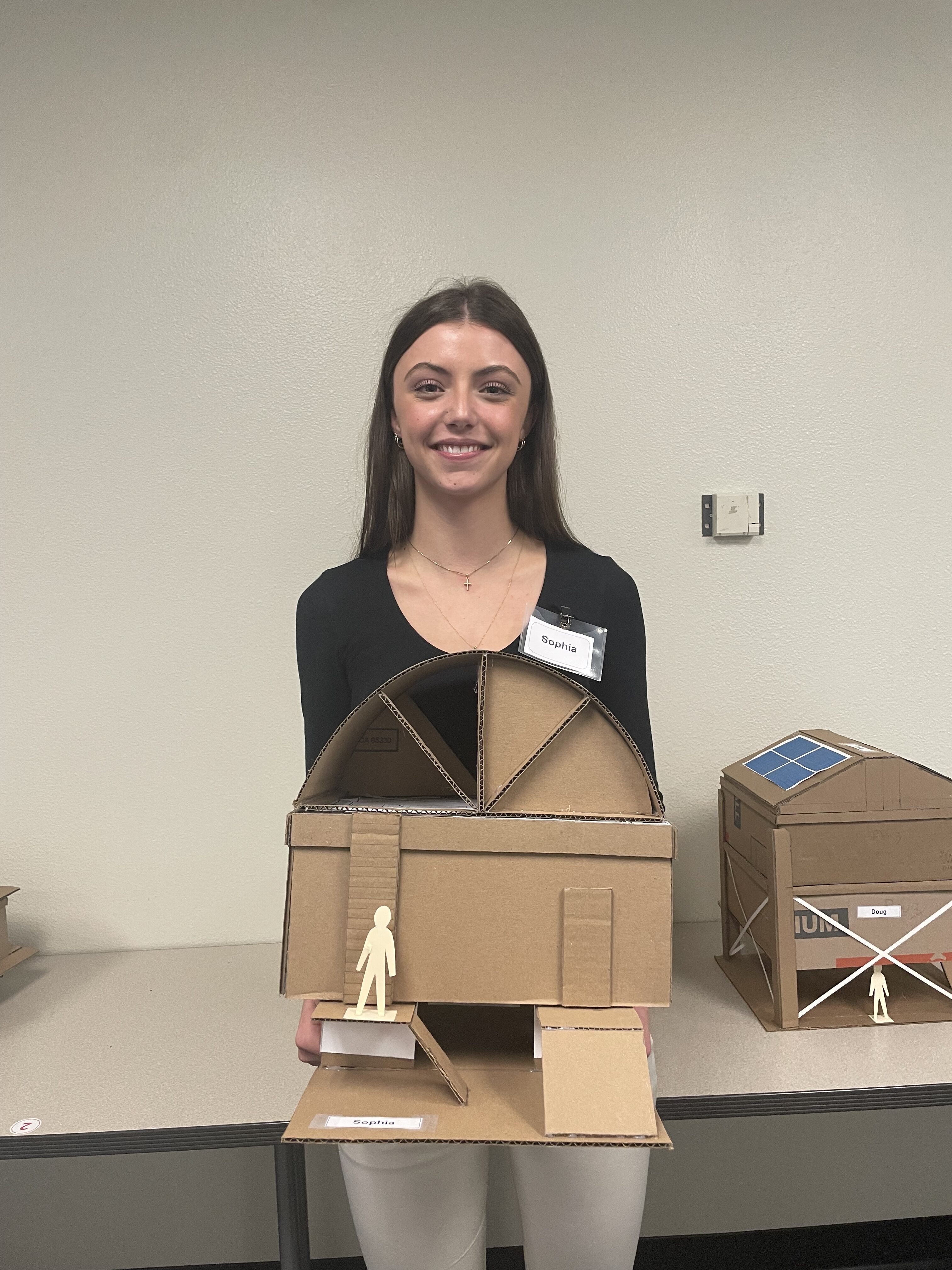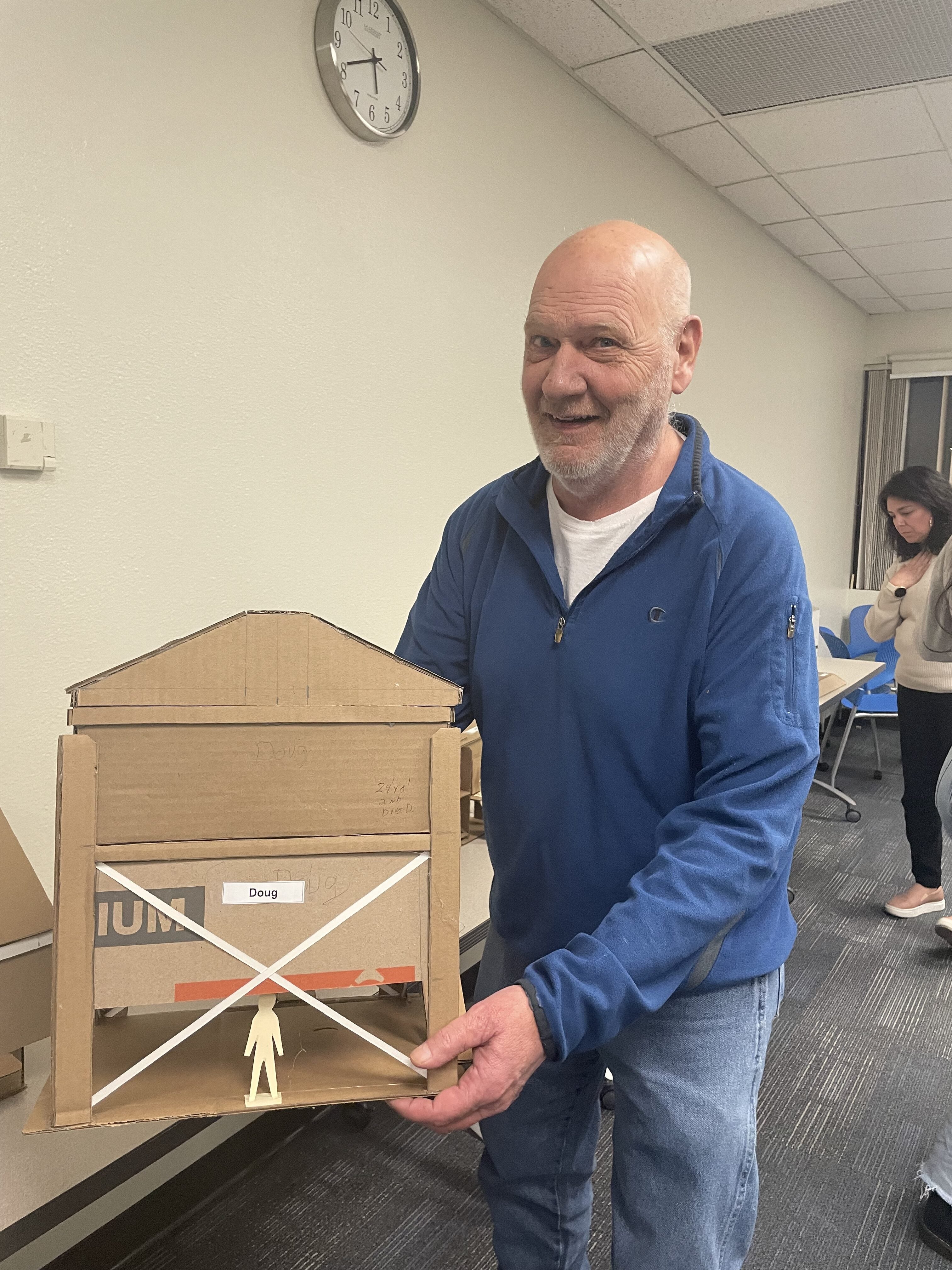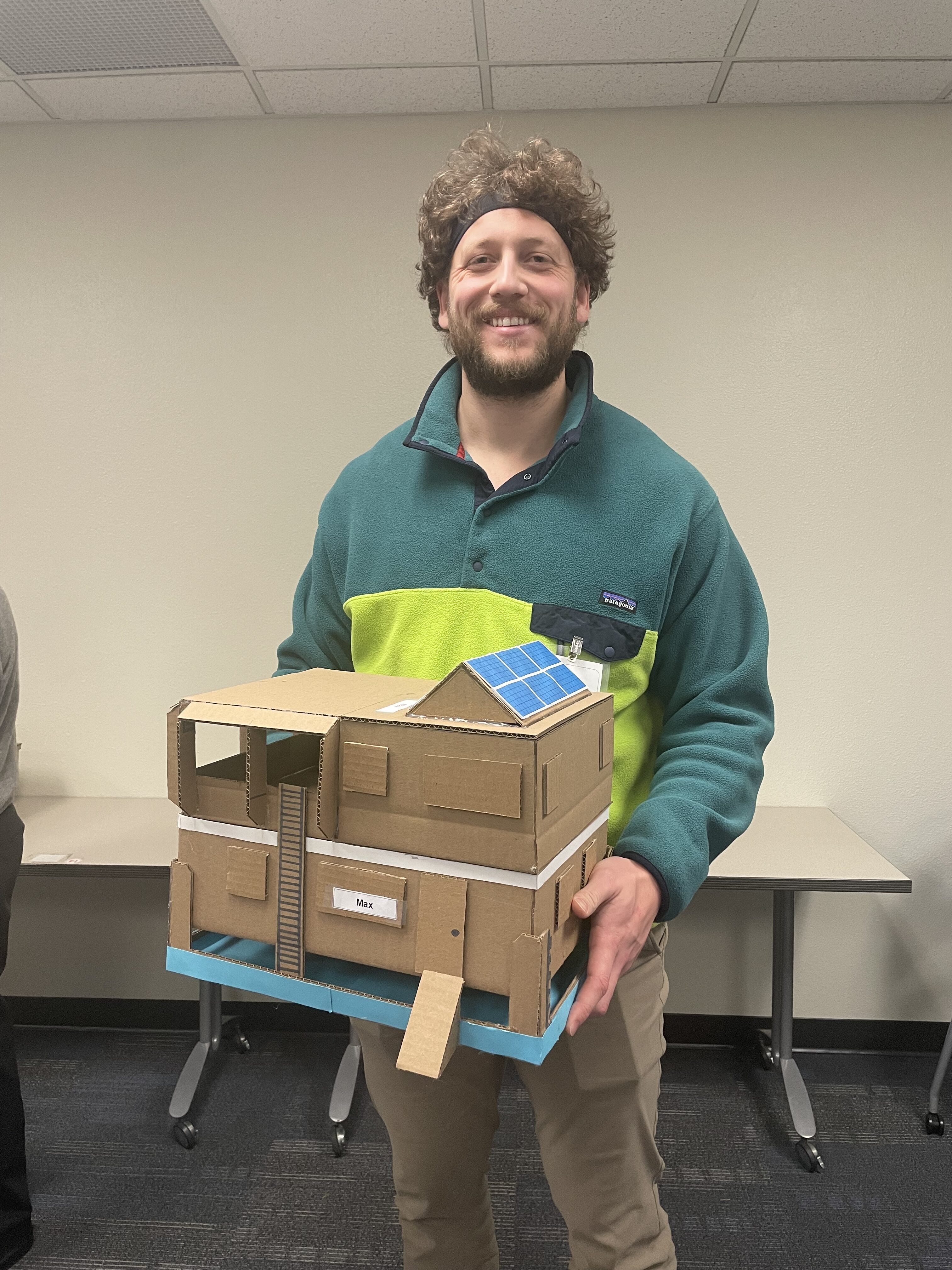Last semester, a group of Boise State University students took a Disaster Preparedness Planning course taught by School of Public and Population Health Professor Uwe Reischl.
In addition to learning about the function of public health in community disaster preparedness planning, the culminating activity in the course required each student to take on the role of an architect who had to design a shelter that would be able to withstand an earthquake, a hurricane, a flood and a forest fire. In addition to considering the structural requirements for such a shelter, each student had to develop an interior space that would make it feasible for a family of four to live there for six months. To demonstrate their final design solution with others, each student had to build a 3D 1/8” scale model of their shelter.
In previous semesters, students were required to design a portable shelter that could be placed anywhere within a city or in a rural setting in response to a natural disaster. This year, students had to think about the form and function of a shelter that could fit within the property lines of a backyard of an average suburban home.
Each student in the class presented their research and their models to a small group of campus community members. This provided the students with an opportunity to explain their ideas to an audience that had not seen their work before. Learn more about the students’ projects below and their takeaways from the course below.
Elizabeth Bricker
Name: Elizabeth Bricker
Major: Master of Public Health Student
Shelter Features: This one thousand square foot shelter featured a slanted roof to withstand hurricane winds and skylights to provide ample light inside the windowless structure.

What does preparedness mean to you?
Preparedness means taking time to think through disasters that could occur in my area, chat with my family about realistic strategies for us, and take actions to be prepared for disasters to occur. This could mean spending $50 on a kit for my car or chatting with nearby family about staying with them in the event of an earthquake.
What was your biggest takeaway from the class and this project?
Disasters create inequity. People living paycheck to paycheck cannot afford to set aside an emergency fund and are less prepared for the calamity that ensues in the wake of a disaster. There are a lot of creative people doing disaster work, and I trust that better and better
Ellie Braun
Name: Ellie Braun
Major: Pre-Nursing Student
Shelter Features: This shelter was built with a five-foot raise in case of flooding.

What does preparedness mean to you?
I definitely have a different outlook on disasters and what it means to be prepared for these disasters. It was incredibly interesting to learn effective ways to prepare using worldly examples and applications.
What was your biggest takeaway from the class and this project?
My biggest takeaway from this class was a new outlook on what it means to be prepared. We were able to think outside the box and create a project that reflects what we think would be the most ideal way to be prepared for any disaster.
Audry Keenan
Name: Audry Keenan
Major: Health Studies Student
Shelter Features: This structure combines both luxury and accessibility with a wrap around porch and ramps that act as potential floatation devices.

What does preparedness mean to you?
Making a plan of action and having the tools to execute that plan is an essential factor in being prepared.
What was your biggest takeaway from the class and this project?
There is always a possibility of a hazard that could negatively affect you, so after being educated through this course I feel as though I am better prepared if something like this did occur.
Sophia Borders
Name: Sophia Borders
Major: Pre-Nursing Student
Shelter Features: This shelter was designed in the style of a quonset hut to help eliminate fire damage.

What does preparedness mean to you?
Preparedness to me not only means planning beforehand and foreseeing future disasters but also implementing procedures in the present in order to maintain readiness at any given moment.
What was your biggest takeaway from the class and this project?
No matter how many times you revise a plan or a model, there will always be room for improvement. Ultimately, a disaster will always have its nuances and it is up to you to do what you can to prepare for them.
Douglas Darneille
Name: Douglas Darneille
Major: Master of Public Health Student
Shelter Feature: This unit was built in the style of a spacious and livable barn.

What does preparedness mean to you?
Knowing what you are able to do when the lights go out, for days!
What was your biggest takeaway from the class and this project?
We are dependent on things for everyday life that we do not produce for ourselves.
Hunter Berry
Name: Hunter Berry
Major: Master of Public Health Student
Shelter Project Overview: This unit was designed with a flat roof to withstand high winds and is raised five feet off the ground in case of flooding.

What does preparedness mean to you?
Preparedness means not only being physically prepared for emergencies but also having knowledge about various emergency situations that one could encounter.
What was your biggest takeaway from the class and this project?
Emergencies are much more devastating when there are no proper safety measures already in place. It definitely was harder than I thought to make a structure that would stand up to all different kinds of emergencies.
Max Curtis
Name: Max Curtis
Major: Pre-Nursing Student
Shelter Project Overview: In case of a flood, this unit was built as a house boat with the ability to attach itself to the family’s main shelter.

What does preparedness mean to you?
Preparedness seems more important and more intricate than ever. The amount of coordination and planning involved is impressive as well as somewhat concerning. It is critical that more people have an understanding of what is involved with emergency planning as well as what is at stake.
What was your biggest takeaway from the class and this project?
My biggest takeaway from the course is that I am not nearly as prepared for a disaster as I previously thought. A huge factor of success is community involvement and I could see, in the event of a real disaster occurring in Boise, that this is the area most would struggle with.
Interested in the topic of disaster preparedness or environmental health?
Learn more abut the Environmental and Occupational Health Sciences emphasis here!